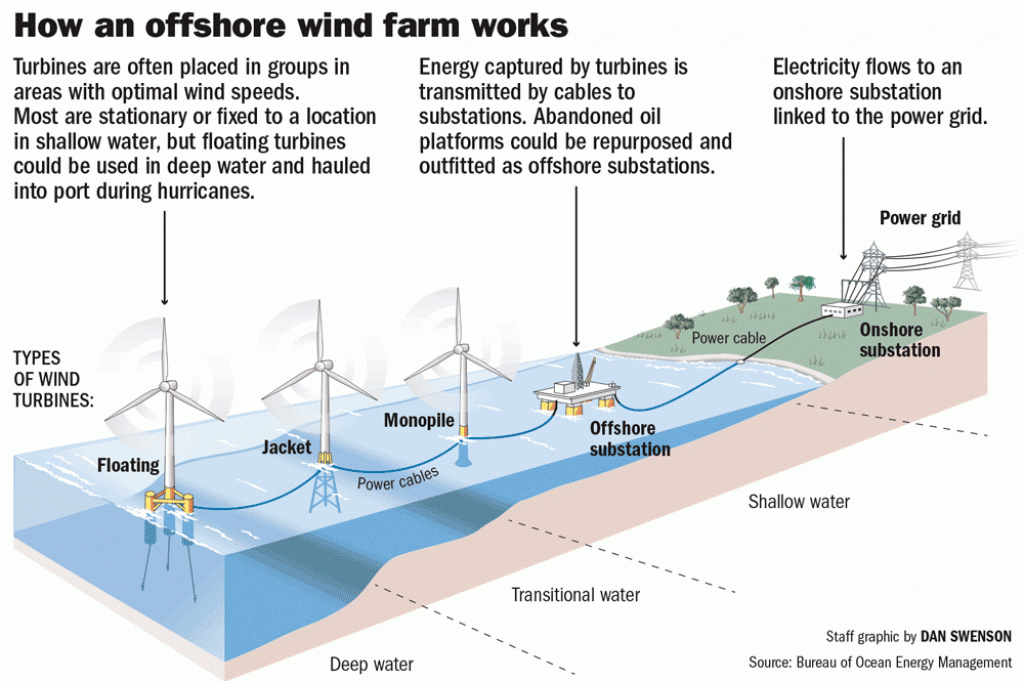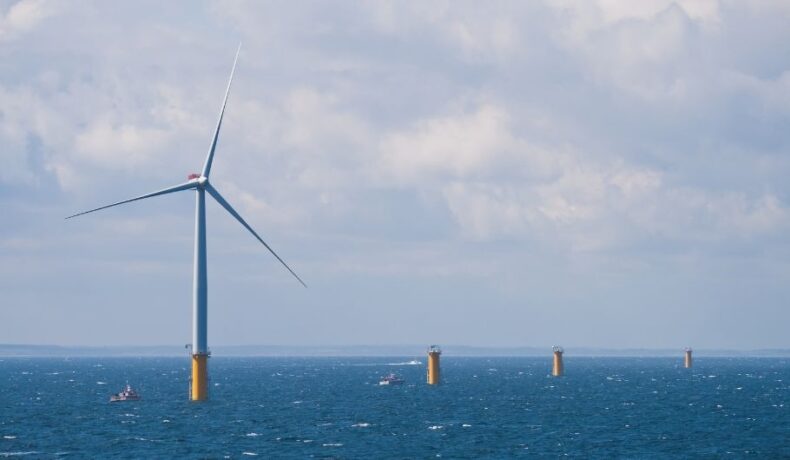Have you ever wondered about the workings of offshore wind turbines?
If you’ve ever taken a road trip along the coast, chances are you’ve witnessed these wonderful machines at work, harnessing renewable energy from wind currents present above the sea.
While not as widespread as other renewable energy technologies, offshore wind turbines are a key component for the decarbonization of electricity. They also contain huge development potential.
For example, in 2018 the European Union had a total electricity demand of 2.884 TWh. Now consider the fact that their total offshore wind potential is 33, 844 TWh.
This means there’s enough offshore wind potential in Europe to cover almost 12 x their energy demand. That means that there’s enough offshore wind potential in Europe to cover almost 12 times their energy demand.
In this article, you’ll learn all there is to know about this technology and its importance in helping to generate clean electrical energy.
Table of Contents
What is an Offshore Wind Turbine?
The Cambridge Dictionary defines the term offshore as “away from or at a distance from the coast”.
In that sense, an offshore wind turbine is basically a wind turbine deployed in the sea.
Where It All Began
While the history of using offshore wind for other purposes is rather old – think navigation – offshore wind turbines and farms (group of turbines) are a relatively new industry.
The first offshore wind farm was called Vindeby, constructed by Danish company Dong Energy (now Orsted) in 1991.

Source: DNV
The Current Situation
The United Kingdom and the European Union are leading the way in installing offshore wind power capacity.
Other big players such as the U.S. and China have had a late start on the deployment of these turbines. They do however have ambitious plans for the future.
Why Build Offshore?
Why would anyone want to build wind turbines in such a difficult place? After all, constructing and maintaining electrical machinery at sea isn’t exactly easy.
The answer lies in the wind resource that can be found offshore. It’s considerably better than wind onshore. This is due to less turbulence, better wind speeds and more consistent airflow.
These characteristics mean that wind at sea has more energy yield and allows for better generation.
How Do Offshore Wind Turbines Work?
An offshore wind turbine works in the same manner as any other wind turbine. If you’d like to know more, check out our previous article on How Wind Turbines Work.
An Extra Step Or Two

However, these turbines and the wind farms that use them require extra steps in order to get the generated energy to the users.
Once the wind turbine and its equipment convert the air current’s kinetic energy into electrical energy, we need to transport it from offshore to a land-based grid.
For that purpose, we transport the energy from all the wind turbines via a collector system. This is a network of underwater high voltage cables (typically 24 to 35 kV) to an offshore substation located close to the wind farm.
The substation increases the voltage to even higher levels (typically 115 to 230 kV) via a step-up transformer. Then, a single underwater circuit sends energy to a substation on land, connected to the electrical grid.
These extra steps help transport energy all the way from generation to the electrical grid. It’s then ready to transport and distribute to users.
How Efficient Are Offshore Wind Turbines?
Wind turbines generally have an efficiency of around 40 – 50%. As such, almost half of the wind’s energy is transformed, while the rest goes unused.
Offshore wind turbines work under the same principle as onshore turbines. As such, we need to use a metric that truly demonstrates why these machines are such a big deal.
Capacity factor – a metric of how much a machine’s capacity is fully used – is one such metric.
Let’s compare the three most relevant and developed renewable energy technologies:
- Offshore wind turbines have the highest annual average capacity factor of all renewable energy technologies, ranging from 29 to 52%.
- In second place comes onshore wind, with a capacity factor ranging from 22 to 44%.
- Solar is in third place, with a capacity factor ranging from 10 to 21% in best cases.
1 MW Wind Turbine Comparison
Let’s compare how the same 1 MW wind turbine would fare on land vs offshore.
We’ll estimate the energy output in a year with the following equation:
A year has 8760 hours. We’ll also consider the best-case scenario of a land wind turbine with an average capacity factor of 44%. The result would be as follows
- EnergyLand = 1 MW x 8760 h x 0.44
- EnergyLand = 3,854.4 MWh
Now, let’s transport our wind turbine to an optimal offshore location, with an average capacity factor of 52%:
- Energyoffshore = 1 MW x 8760 h x 0.52
- Energyoffshore = 4,555.2 MWh
Just by placing the same wind turbine offshore, we have gained an extra 18% increase in energy, isn’t that great?
You might think that this outstanding performance is enough reason to prioritize the development of offshore wind farms against other renewable energy technologies. However other factors come into play, as we’ll see ahead.
How Much Does An Offshore Wind Turbine Cost?
As you might already suspect, offshore wind turbines are more expensive than their counterparts on land.
This is because of the following reasons:
- Building an structure offshore is a difficult challenge, way more difficult than building on land.
- Foundations – a critical and expensive element of a wind turbine – have different and more complex designs than those on land.
- In order to withstand harsh conditions on sea – such as corrosion, high winds and water currents – the wind turbine itself requires a more robust structure and special materials.
These reasons resulted in an average cost of installed offshore wind energy in 2020 of $3.720 per installed kilowatt.
While almost tripling the cost of onshore wind turbines, the industry has reached a cost reduction of 35% from its peak in 2013 – 5,721 USD/kW. This is a great improvement.
More importantly, this trend is expected to continue, reaching costs around 1,000 USD/kW in the following 10 to 15 years.
To understand the costs of a whole offshore wind farm, let’s take a look at the largest farm up to date, Hornsea Project 1. It consists of 174 wind turbines and a total installation rated capacity of 1.218 MW.
Using our average cost of 3,720 USD/kW, the estimated cost of the wind farm is USD 4.53 Billion.
How Much Electricity Do Offshore Wind Turbines Produce?
The electricity output of a single offshore wind turbine depends on two factors:
- The turbines rating.
- The availability of the wind resource.
To understand how much they contribute to clean energy generation, let’s take a look at the following metrics:
- During 2018 all offshore wind turbines in the world generated a total of 67 TWh. The average U.S. home consumes 11.000 kWh. Taking those figures into consideration, that 67TWh supplied a total of 6 million families.
- Even though it seems to be a big number, it only accounts for 0.3% of total electrical energy consumption worldwide.
- Using an average capacity offshore wind turbine of 7.8 MW (average value in 2019), and a modest capacity factor of 46%, a single, recently installed wind turbine could generate 31.4 GWh, enough to power almost 3000 households.
- The manufacturer Vestas claims that its latest offshore wind turbine model, the V236-15MW, can generate as much as 80 GWh in a year. That’s more than 7000 households covered with a single turbine.
How Long Do Offshore Wind Turbines Last?
We’ll answer this by looking at their design life. This determines how long equipment will last.
Most manufacturers offer wind turbines with a design life of around 20 – 25 years.
Nevertheless, a well-maintained wind turbine that has not been exposed frequently to extreme weather conditions can last longer, with some cases of offshore wind farms having their lifetime extended to 30 years.
Even though their life can be extended even further, it’s not the most economically viable option, as operation and maintenance costs of old equipment only rise over time. At a certain point, this becomes unsustainable.
Such is the case of the first offshore wind farm we used as an example earlier. Offshore wind farm Vindeby was built in 1991 and decommissioned in the year 2017 – a total of 26 years.
Because of this, wind farm sites go through a “repowering” process, which is basically removing all the old turbines and replacing them with newer and better ones, while using the same location.
In the long term, this is the best solution, as the repowered wind farm will work more efficiently and generate more revenue than just keeping the old farm functioning.
3 Advantages of Offshore Wind Turbines
While we’ve covered some of their advantages before, we can sum up the most important ones below:
- Optimal Wind Resource: Some of the best wind conditions for energy generation can be found offshore, such as strong, steady and low turbulence winds. It’s also readily available for most countries with coast.
- Capacity Factor: The highest among all renewable energy technologies, which means the turbine’s capacity is being used more efficiently.
- Less Public Opposition: Since they are placed offshore, far from urban areas and without the existence of landowners, public acceptance of these wind farms is higher.
3 Disadvantages of Offshore Wind Turbines
As the saying goes, all that glitters is not gold, and offshore wind turbines are no different. They do have some disadvantages compared with other types of renewable energy technology.
- Location: Probably the most obvious one. As they are placed offshore, accessibility for construction, operation and maintenance requires additional equipment, machinery and trained personnel. This makes them far more expensive.
- Effects On Marine Life: While it’s not yet a fully studied effect, the placement of wind turbines could disturb marine migration routes and the local sea ecosystem. Fishing industry can also be affected in this way.
- Environmental Contamination: As wind turbines use certain chemical components for lubrication and refrigeration purposes, a leak during machinery failure could have more severe effects.
While it’s unfortunate that wind turbines come with disadvantages, these can instead be seen as opportunities for improvement in the industry.
Final Thoughts
Offshore wind turbines are amazing technological developments, with an important role in helping us reach sustainability in the electricity we consume.
The availability and potential of the wind resource at sea will drive the future development of more offshore wind farms. We’ve already seen this happen recently in China and the United States.
Sure, if you compare these machines to other forms of renewable energy tech, they’re costly. But, cost trend reduction allows us to envision a future where offshore wind plays a much bigger role, worldwide.

